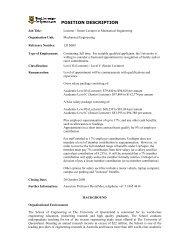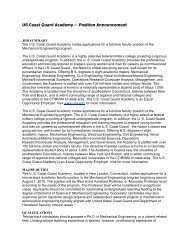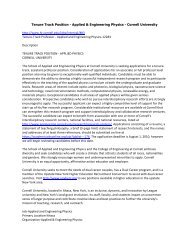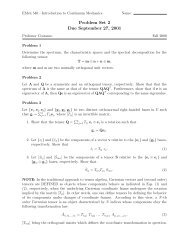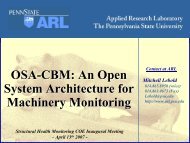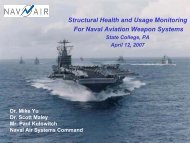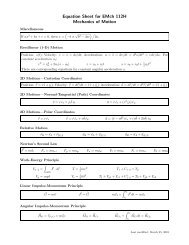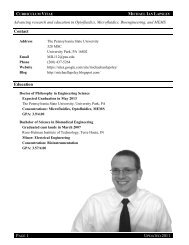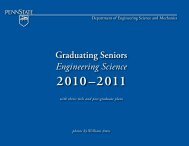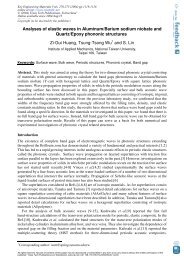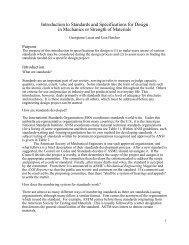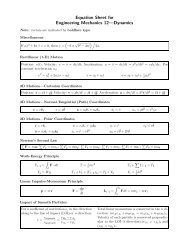Miniaturisation for chemistry, physics, biology, & bioengineering
Miniaturisation for chemistry, physics, biology, & bioengineering
Miniaturisation for chemistry, physics, biology, & bioengineering
Create successful ePaper yourself
Turn your PDF publications into a flip-book with our unique Google optimized e-Paper software.
PAPER www.rsc.org/loc | Lab on a Chip<br />
Acoustic tweezers: patterning cells and microparticles using standing surface<br />
acoustic waves (SSAW)†<br />
Jinjie Shi, a Daniel Ahmed, a Xiaole Mao, ab Sz-Chin Steven Lin, a Aitan Lawit a and Tony Jun Huang* ab<br />
Received 29th May 2009, Accepted 22nd July 2009<br />
First published as an Advance Article on the web 5th August 2009<br />
DOI: 10.1039/b910595f<br />
Here we present an active patterning technique named ‘‘acoustic tweezers’’ that utilizes standing surface<br />
acoustic wave (SSAW) to manipulate and pattern cells and microparticles. This technique is capable of<br />
patterning cells and microparticles regardless of shape, size, charge or polarity. Its power intensity,<br />
approximately 5 10 5 times lower than that of optical tweezers, compares favorably with those of<br />
other active patterning methods. Flow cytometry studies have revealed it to be non-invasive. The<br />
a<strong>for</strong>ementioned advantages, along with this technique’s simple design and ability to be miniaturized,<br />
render the ‘‘acoustic tweezers’’ technique a promising tool <strong>for</strong> various applications in <strong>biology</strong>,<br />
<strong>chemistry</strong>, engineering, and materials science.<br />
Introduction<br />
The ability to arrange cells and microparticles into desired<br />
patterns is critical <strong>for</strong> numerous biological studies and applications<br />
such as microarrays, 1,2 tissue engineering, 3,4 and regenerative<br />
medicine. 5,6 Researchers have developed a variety of<br />
patterning techniques such as microcontact printing, 7–9 optical<br />
tweezers, 10,11 optoelectronic tweezers, 12,13 magnetic tweezers, 14–16<br />
electro-/dielectro-phoresis, 17–21 evanescent waves/plasmonics, 22,23<br />
hydrodynamic flows, 24–32 and bulk acoustic wave-based acoustophoresis.<br />
33–37<br />
The invention of optical tweezers 10,11 and developments in<br />
optofluidics 38–41 have spurned a new plat<strong>for</strong>m <strong>for</strong> manipulating<br />
and patterning micro/nanoscale objects with unprecedented<br />
precision. Chiou et al. demonstrated optoelectronic tweezers that<br />
featured not only the high precision of optical tweezers, but also<br />
achieved high throughput and low power consumption, with<br />
a power intensity approximately 1 10 5 times less than that of<br />
optical tweezers. 12 Most recently, Yang et al. demonstrated<br />
trapping and transporting dielectric nanoparticles as small as<br />
75 nm using sub-wavelength slot waveguides. 42 Despite the<br />
impressive per<strong>for</strong>mance of such optics-based patterning and<br />
manipulating techniques, they require bulky, complicated optical<br />
setups, which are difficult to miniaturize. Techniques based on<br />
magnetic/electrical fields (such as magnetic tweezers, electrophoresis,<br />
and dielectrophoresis) 14–21 could serve as alternative<br />
solutions. These techniques are amenable to device miniaturization,<br />
but they have limited versatility. For example, magnetic<br />
tweezers require targets to be pre-labeled with magnetic materials.<br />
The recently developed bulk acoustic wave (BAW)-based<br />
a Department of Engineering Science and Mechanics, The Pennsylvania<br />
State University, University Park, PA, 16802, USA. E-mail: junhuang@<br />
psu.edu; Fax: +1 814-865-9974; Tel: +81 14-863-4209<br />
b Department of Bioengineering, The Pennsylvania State University,<br />
University Park, Pennsylvania, 16802, USA<br />
† Electronic supplementary in<strong>for</strong>mation (ESI) available: Including device<br />
fabrication, simulation of standing surface acoustic waves, flow<br />
cytometry measurements, qualitative <strong>for</strong>ce analysis and ID and 2D<br />
patterning of fluorescent microparticles. See DOI: 10.1039/b910595f<br />
acoustophoresis have shown promise in manipulating macro/<br />
micro particles regardless of their optical or electrical properties.<br />
33–37 However, it is challenging to implement these BAWbased<br />
techniques with the existing fast-prototyping methods,<br />
such as soft lithography, that are widely used in microfluidics.<br />
Due to the limitations of the existing techniques, researchers are<br />
still searching <strong>for</strong> cell-patterning techniques that simultaneously<br />
meet specifications <strong>for</strong> miniaturization, versatility, throughput,<br />
speed, and power consumption.<br />
A surface acoustic wave (SAW) is a sound wave that propagates<br />
along the surface of an elastic material. 43 When SAW<br />
propagates, most of its energy is confined within one to two<br />
wavelengths normal to the surface of the substrate. 43 This energyconfining<br />
characteristic makes SAW an energy-efficient tool <strong>for</strong><br />
manipulating particles and biomaterials. Furthermore, SAWbased<br />
techniques are free of contamination, only introducing<br />
low-power mechanical vibrations to the suspension. Recently,<br />
researchers have demonstrated SAW-based mixing, 44 pumping, 45<br />
concentration, 46 and particle focusing. 47 In this paper, we reveal<br />
an ‘‘acoustic tweezers’’ technique, in which microparticles and<br />
cells can be effectively patterned using standing surface acoustic<br />
waves (SSAW). This technique is versatile, non-invasive, and<br />
amenable to miniaturization, and its power consumption<br />
and speed compare favorably to those of existing active cellpatterning<br />
techniques.<br />
Working mechanism<br />
Fig. 1 illustrates the working principle of the ‘‘acoustic tweezers.’’<br />
The device consists of a polydimethylsiloxane (PDMS) microfluidic<br />
channel and a pair of interdigital transducers (IDTs)<br />
deposited on a piezoelectric substrate in a parallel (Fig. 1a) or<br />
orthogonal (Fig. 1b) arrangement. A solution of microparticles<br />
or cells is infused into the microchannel by a pressure-driven<br />
flow. Once the distribution of particles or cells stabilizes in the<br />
channel, a radio frequency (RF) signal is applied to both IDTs to<br />
generate two series of identical SAWs propagating either in the<br />
opposite (Fig. 1a) or orthogonal (Fig. 1b) direction. The interference<br />
of these two series of SAWs <strong>for</strong>ms a SSAW, as well as<br />
2890 | Lab Chip, 2009, 9, 2890–2895 This journal is ª The Royal Society of Chemistry 2009




